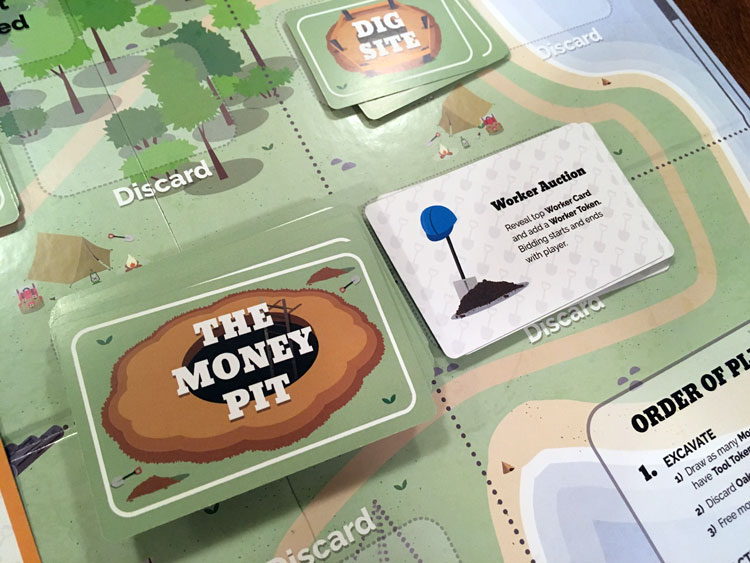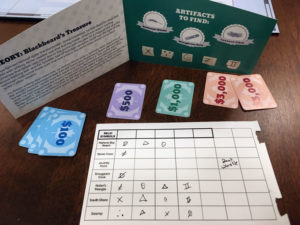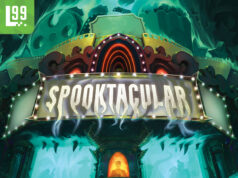Note: This preview uses pre-release components and rules. What you see here may be different from the final, published game. This post was a paid preview, you can find out more information here.
 Nearly 40 years ago, a television show called “In Search Of” hosted by Leonard “Spock” Nimoy aired an episode called “The Money Pit”. The show tells the true story of the discovery of a hole on the infamous Oak Island off the coast of Nova Scotia. The location, structure and findings around the pit have inspired treasure hunters, mystery fans and amateur scientists trying to understand its purpose.
Nearly 40 years ago, a television show called “In Search Of” hosted by Leonard “Spock” Nimoy aired an episode called “The Money Pit”. The show tells the true story of the discovery of a hole on the infamous Oak Island off the coast of Nova Scotia. The location, structure and findings around the pit have inspired treasure hunters, mystery fans and amateur scientists trying to understand its purpose.
Although this writer was very young at the time of the show, this series, also a favorite of my dad’s, seeded in me a love of unsolved mysteries. That need to know answers to complex and unexplained stories has always inspired me.
With The Money Pit of Oak Island, at least one game designer is willing to take on this ultimate mystery. For those that need some kind of resolution to this mystery, this game aligns where deduction meets strategy.
Game Overview:
Armed with a fixed budget, the players in The Money Pit of Oak Island represent various individuals with theories about what the Money Pit means. Each player starts the game with a set of artifacts required to prove their theory and progress through various dig sites to discover what lies beneath the island.
How to Play:
Players begin the game with a named character that carries a backstory which aligns with a particular theory. These backstories are particularly interesting and can even offer some ad hoc roleplaying moments. Some characters are seeking a scientific resolution while others are mere treasure hunters looking for fortune, or at least, a little fame to jumpstart a career.

Each character provided has a small cardboard shield for concealing a player’s remaining money. It also acts as a display to show which artifacts need to be revealed for the player’s theory. In addition, it also shows five stone symbols such as a triangle or three dots. These symbols will align with the symbols to be found at one of the many dig sites on the island board. If a player finds a dig site with all five symbols that match their character shield, they’ve found the right dig site.
To prepare the main board, which shows a map of the island, piles of cards are allocated to dig sites. Each prepared pile contains four “dirt” cards, five different symbol cards, and a single artifact card. Players can direct their character’s tent (their character’s location on the island) to one of these dig sites and reveal the cards through game actions. If a player finds an artifact, they may choose to reveal it. Doing so can help their theory if the item matches one on their shield, or it may not be necessary to reveal since it may only help an opponent in the game.
The main board also contains three other decks. The Money Pit deck contains cards which provide certain player actions and also control one of the game timers. The Worker deck cards give players the chance to hire new workers and receive special actions or upgrades. The Event! deck contains random events which will occur as players progress through digging through the Money Pit deck. These events can wreak havoc as players get closer and closer to revealing their theory.
During setup, players start at a dig site and receive an amount of money based on the number of players. Finally, players receive one worker token and two tool tokens.
Turns for each player proceed through three steps. On a turn a player completes the following:
Excavate – A player draws from the Money Pit deck equal to the number of tool tokens they have. A player can also move their tent to another dig site at this time. If a player draws “Oak Platform” cards from the deck, these are set aside and are not included in the draw count.

Actions – Players receive a number of actions equal to the number of worker tokens they have. These actions would be to play a Money Pit card, Dump Dirt on another player’s dig site, use a Worker Card action, move to an adjacent dig site, or finally, Discover a Relic. This last action assumes the player has information that indicates they are at the appropriate dig site and it has been completely excavated.
Money Pit cards can give players actions to dig through the decks at the various dig sites (hoping to find artifacts or symbols), hire workers by beginning an auction, or purchase tool tokens. The auctions for workers are most intense because each player may only bid once, and these tokens, as mentioned above, directly affect how many actions players receive.
Resolve – At the end of their turn, a player removes any unplayed Money Pit cards from the game. Then they draw an Event! card if the total number of Oak Platform cards that have been set aside (from any players’ draws) is equal to three or more.
The result of the third step has two effects. As cards are removed permanently from the Money Pit deck, the likelihood of drawing Oak Platform cards gets higher and higher. Also, as soon as seven Event! cards have been drawn, or the supply of Money Pit cards is not enough for the player to draw, the game ends.
In the case where the Event! cards end the game, all players lose if they have not completed their excavation in time. If the game ends by depletion of the Money Pit cards, the win condition depends on at least one player having proven their theory by revealing the correct Relic. If two or more players happen to do this, the player with the most money remaining wins.

Game Experience:
For this writer, one really underused and greatly appreciated game mechanism is fixed resources. In The Money Pit of Oak Island, since players never receive any new funds, what they spend for workers or tools limits their flexibility during the rest of the game. Knowing just how far to push the bid during an auction is crucial.
Later, as players work on working through dig sites, the strategy of the right balance of workers to tools also comes into play. If a player has many more tools than workers, then they’re just going to be wasting valuable dig cards drawn from the Money Pit deck. Keeping just the right number of workers to get the most out of cards drawn is another challenge that draws players into the game.

Besides the ratio of workers to tools, it’s just as important to keep the right workers. Some workers have additional actions or protections which are more valuable than others. As players bid in an auction, keeping these things in mind will help in knowing when to bid really high to acquire a card and when to push the bid just to make sure someone over pays for a worker that really isn’t valuable.
The one aspect of The Money Pit of Oak Island which could use some review is the game length. According to the publisher, the game clocks in at 45 minutes per player. This is not a low ball number from a publisher. Playing the game reveals this to be pretty accurate for a first play. Players can also rush the ending of the game, so the game time can vary. But if players are really playing cautiously or alternatively buying lots of tools, the game time can vary widely. This is a danger since depending on which game timer causes the game to end, either all players could lose or aggressive players can end the game prematurely for themselves.
Finally, the main thing to understand about how The Money Pit of Oak Island plays is that this is very much a deduction strategy game. The winning condition is directly related to how much information you can get from the various dig sites and being able to determine the correct dig site quickly is the primary goal. Eliminating dig sites from consideration or finding artifacts before others is the surest way to win.
Final Thoughts:
Taking a look at The Money Pit of Oak Island, it was refreshing to see a rarely used game mechanism work itself perfectly into the theme. The game is not heavy, but strategy and consideration of worker and tool management comes into focus quickly. Due to the time issues, a first game shines with three players. If you’re looking for a game that combines strategy, deduction and budget considerations, give The Money Pit of Oak Island a try.
The Money Pit of Oak Island is currently available on Game Crafter if you’d like to check it out. The publisher also has plans to bring this game to Kickstarter in the future.
As always, we don’t post ratings for preview copies as the components and rules may change from the final game. Check back with us after the game is produced for a full review. This post was a paid preview, you can find out more information here.





















